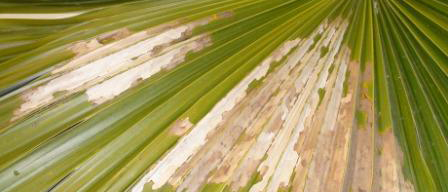Palm Leaf Skeletonizer

Florida-Friendly Landscaping™ in a Minute
Episode Archive
Episode #345 | Original Air Date: June 25, 2021
Related Resources
Transcript
The palm-leaf skeletonizer is a moth whose larvae feed on palm fronds.
Cabbage palms throughout Florida are the favorite plant of this insect. It surrounds itself with conspicuous dark tubes made of silk and excrement.
It consumes the tissue of the leaf between the veins. This behavior results in the characteristic “skeleton” look that gives the moth its name.
The palm-leaf skeletonizer often feeds on the undersides of fronds, and the damage shows up on the tops of the leaves as dead tissue.
The best control for this pest is to detect its presence early. Washing the larva and its tubes off with a wet sponge or high-pressure hose may prevent further damage.
Florida-Friendly Landscaping™ in a Minute is a production of the University of Florida’s Florida-Friendly Landscaping™ Program, IFAS Extension, and WUFT-FM in cooperation with the Florida Department of Environmental Protection.

